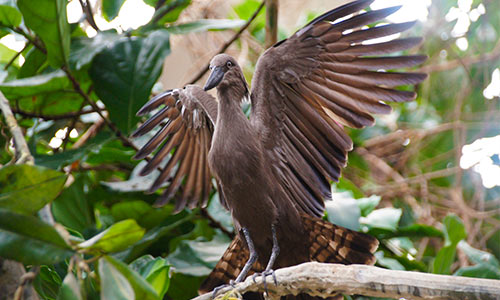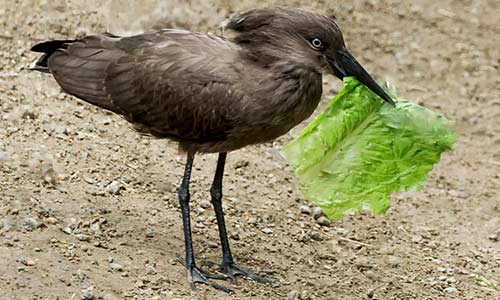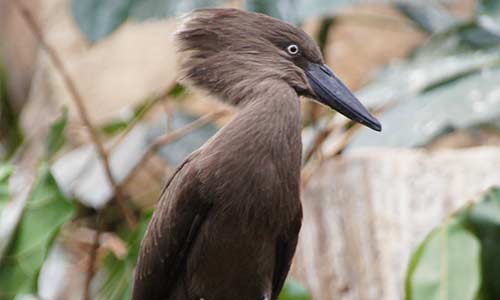Hamerkop
Scopus umbretta
About the Hamerkop
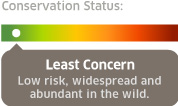
Geographic Range:
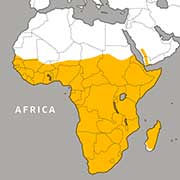
Class: Aves
Order: Pelecaniformes
Family: Scopidae
Genus: Scopus
Species: umbretta
Hamerkops, named for their distinctive hammer-shaped heads, build the largest domed nests of any bird. These massive nests can weigh up to 55 pounds and are comprised of any available vegetation along with any colorful decorative material. Accessible only by a small, narrow entrance hole, the birds fly straight into their nests. In the wild, the nests attract a wide array of other wildlife who will either push the hamerkops out of their nest or take up residence after the birds have left.
While anatomically hamerkops share characteristics with both storks and herons, due to their unique attributes these distinct birds are placed in their own family – the Scopidae. Hamerkops, the subject of many myths, are plentiful across sub-Saharan Africa and Madagascar, and as long as there is access to water they can be found in a range of habitats including forests, savannahs and semi-deserts.
These wading birds forage for food, mainly frogs and fish, in shallow water. When looking for fish, they spread their wings creating an umbrella effect to attract and more easily catch fish.
Hamerkop Facts
Appearance:
The hamerkop is a medium-sized water bird with brown coloring. It has a long, thick, sharp beak (used for spearing prey) and partially webbed feet. The hamerkop's large wings are used to glide and soar.
Size:
- Length: Up to 20 inches
- Weight: One pound
- Wingspan: Up to eight feet
Diet:
Hamerkops are carnivorous, eating tadpoles, frogs, fish shrimp, insects and small mammals.
Mating/Reproduction:
This species breeds year-round in some areas or in the dry season in others, depending on the local climate. Up to 10 hamerkops perform a mating dance, during which the birds hop around, display their crests, and perform false mounts. These birds are typically found in mated pairs. Though pairs stay together for life, they build a new nest every year. They even build multiple nests each year before settling on one.
Both the male and female hamerkop aid in building a nest that can reach six feet tall, weigh 150 pounds and take four months to complete. The female lays three to seven eggs that are incubated by both parents over the course of 30 days. Hatchlings leave the nest 50 days later.
Median Life Expectancy:
Males:12.3 years
Females: 5.9 years
Habitat/Range:
The hamerkop is found throughout sub-Saharan Africa in forests, wetlands and the savannah.
You Can Find This Animal in the Tropical Forest
Committed to Conservation
Zoo New England participates in the hamerkop Species Survival Plan. By sharing research and knowledge, participating institutions work together to establish guidelines that best ensure the health of captive populations, and with success, the survival of endangered species.
You might also like
At Franklin Park Zoo:
At Stone Zoo:

